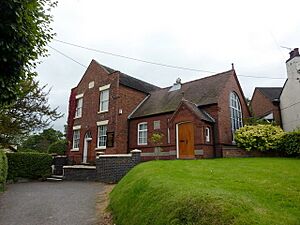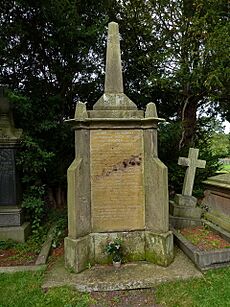Englesea Brook Chapel and Museum facts for kids
The Englesea Brook Chapel and Museum is a special place in the village of Englesea-Brook, Cheshire, England. It started as a chapel in 1828. This chapel was one of the first places for a group called the Primitive Methodists to meet.
Later, in 1914, a Sunday school was added. Since 1986, the building has been a museum. It tells the story of the Primitive Methodist movement. The chapel is also a Grade II listed building, which means it's an important historic place. Inside, you can see an old pipe organ. The museum also has many items from the past. It often hosts new exhibits and events. Outside, in the graveyard, there's a monument for Hugh Bourne. He was one of the people who started the Primitive Methodist movement.
Contents
A Look Back: The Chapel's History
The chapel was built in 1828. Many people believe it's the oldest building made just for Primitive Methodists. This movement began with outdoor meetings in 1807. These meetings were organized by Hugh Bourne at a place called Mow Cop. For many years, people met outside or in private homes. They were very enthusiastic about their faith. Because of this, some people called them "ranters."
The chapel was changed a bit in 1832. This is when the front entrance was added. An upper floor, called a west gallery, was also put in. The Sunday school building was added next to the chapel in 1914. In 1986, the building was fixed up. That's when it became the museum we know today.
What the Building Looks Like
The old chapel and school are made of red brick. They have special stone decorations. Both buildings have stones that show when they were built. The chapel's front entrance is in the middle. It has a fancy frame and a fan-shaped window above the door. There are sash windows on each side of the door. More windows are above these. All the windows have stone sills.
The school building is attached to the right side of the chapel. It has one floor and a small entrance area. Stone steps lead up to the chapel. In front of the chapel, there's a wall with cast iron railings. In 1979, the chapel and school were officially named a Grade II listed building. This means they are important to protect.
Inside the Chapel
Inside the chapel, you can see box pews from 1832. These are like old-fashioned seating areas. Other furniture, mostly from 1892, includes a pulpit and a raised platform called a dais. The chapel also has the very first organ used in a Primitive Methodist chapel. This organ was first used in a chapel in Silsden. Then it moved to a chapel in Bradley in 1850.
Later, the organ went to a private house in Burnley. Its owner then gave it to the museum. It was set up in the museum in 1987. It was fixed up even more in 2007. It's a small pipe organ with one keyboard and three different sounds. You play it by pumping with your foot. In 2004, it received a special award for being a historic organ.
The Graveyard and Hugh Bourne's Monument
Across the road from the chapel is its graveyard. Here, you'll find a monument to Hugh Bourne. He was one of the founders of the Primitive Methodist movement. He passed away in 1852. The monument was designed by John Walford. It's made of stone with letters carved in lead.
The monument has a square base. At each corner, there are steps that lead up to small pointed decorations. On top of the base is a taller, pointed stone called an obelisk. The base has words carved into it. These words tell about Hugh Bourne's life and what he achieved. This monument is also a Grade II listed building.
Visiting the Museum Today
The museum is looked after by the Methodist Heritage Committee. It is open to visitors from Thursdays to Sundays, from April to October. Groups might need to pay a small fee, but individual visitors can enter for free. If you want to visit when the museum is usually closed, you can arrange a special visit.
The museum hosts several Christmas events each year. They also have online events throughout the year. Inside the museum, there's a tea room and a shop. The museum often changes its exhibits, so there's always something new to see. You can see a pulpit that was used by Hugh Bourne. It was also used by William Clowes, who helped start the movement. This pulpit was originally in a private house in Tunstall. The museum also has a printing press that Hugh Bourne used. You can even see the sea chest he took with him when he visited Canada in 1844. There's also a list of everything that was inside it!
See also
- Listed buildings in Weston, Cheshire East





